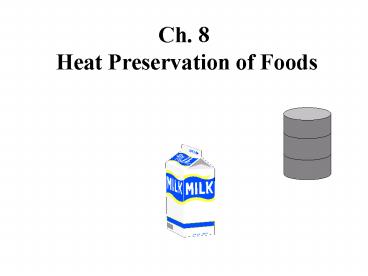Ch' 8 Heat Preservation of Foods - PowerPoint PPT Presentation
1 / 27
Title:
Ch' 8 Heat Preservation of Foods
Description:
All pathogenic & toxin-forming organisms are dead (applies to ... Extends product shelf life (but not extensively) Ex: milk, beer, fruit juices, liquid eggs ... – PowerPoint PPT presentation
Number of Views:750
Avg rating:3.0/5.0
Title: Ch' 8 Heat Preservation of Foods
1
Ch. 8 Heat Preservation of Foods
2
- Cooking/heating foods
- kills some microorganisms
- destroys most enzymes
- improves shelf life
- does not indefinitely preserve
3
Degrees of Preservation
- Sterilization
- Complete destruction of microorganisms
- 121oC (250oF) for 15 minutes (internal temp)
- Commercially Sterile
- All pathogenic toxin-forming organisms are dead
(applies to most preserved foods)
4
- Pasteurization - Temps lt 100oC (212oF)
- Destroys pathogenic microorganisms
- Extends product shelf life (but not extensively)
- Ex milk, beer, fruit juices, liquid eggs
- Blanching
- Primarily used for fruits vegetables
- Deactivates enzymes
- Kills some bacteria
5
Selecting Heat Treatments
- Heat that is sufficient to destroy all
microorganisms and enzymes is detrimental to
other food quality factors such as - Color
- Flavor
- Texture
- Nutrition
- Consistency
6
To pick the right heat treatment severity for a
specific food you must determine...
- Time/temperature combination required to
inactivate the most resistant microbe - Heat penetration characteristics of
- the food (varies with consistency, particle size)
- the container (varies with size, shape, material)
7
Time/temperature combination required to
inactivate the most resistant microbe
- The most heat resistant pathogen in canned foods
is Clostridium botulinum (botulism) - Therefore, must use time/temperature combination
adequate to kill this species
8
Thermal Death Curves
- Heat kills bacteria logarithmically
- i.e. If 90 are killed in the first minute at a
certain temperature, then - 90 of those remaining alive will die during the
second minute, and - 90 of those remaining alive will die during the
third minute, etc. - Spores are more heat resistant than vegetative
cells
9
Margin of Safety
- Unknowns in raw foods, especially those which are
low acid - types of microbes present
- number of microbes present
- Therefore assume
- C. botulinum to be present in large numbers
10
1,000
100,000/ml
100
10,000/ml
Killing time (min)
1,000/ml
10
1
210
230
250
TEMPERATURE (oF)
Thermal death curves for bacterial spores at
different initial concentrations.
11
Food Processing Requirements Based Upon Acidity
(pH)
12
Food Processing Requirements Based Upon Acidity
(pH)
13
Food Processing Requirements Based Upon Acidity
(pH)
14
HEAT TRANSFER
- Every food particle inside a can must reach the
critical temperature for the required time - Factors affecting heat penetration include
- size of can
- shape of can
- consistency of the food item (thick or thin)
- nature of the food (particulate vs liquid)
15
Principals of Heat Transfer
- Conduction
- from one particle to another by contact
- food particles in can do not move
- Convection
- movement inside can distributes heat
- Radiation
- energy transfer through a medium which itself is
not heated
16
Thermocouple Placement atCold Point in Can
17
Protective Effects ofFood Constituents
- Sugar protects bacterial spores in canned fruit
- Starch protein protect spores
- Fats Oils protect bacterial spores
18
Examples of Process Times
19
Time-Temperature Combinations
- From thermal death curves, the following
time/temperature treatments yield the same
microbe killing effect - 0.78 min _at_ 127oC 10 min _at_ 116oC
- 1.45 min _at_ 124oC 36 min _at_ 110oC
- 2.78 min _at_ 121oC 150 min _at_ 104oC
- 5.27 min _at_ 118oC 330 min _at_ 100oC
20
Heating Before orAfter Packaging
- After
- simplest
- oldest form of preservation using heat
- Before
- less damaging to food
- requires aseptic packaging
21
Temperature/Pressure Relationship
- 10 psi 116oC
- 15 psi 121oC
- 20 psi 127oC
22
Heating Food in Containers
- Still Retort
- Max temp of 121oC to prevent food damage near can
wall - Long cook time
- Agitating Retort
- Shorter cook time
- Less food damage
23
- Hydrostatic Retort
- Continuous flow of cans
- Uses hydrostatic head
- to control pressure
- Is an agitating system
24
Heating Food Prior to Packaging
- Pasteurization (liquid products)
- Batch
- Product in steam-jacketed kettle heated to
specified temperature and rapidly cooled - (ex. milk heated to 145oF for 30 min)
- Continuous
- High Temp Short Time (HTST)
- Ex. Milk heated to 161oF for 15 sec.
25
Aseptic Packaging
- Food is sterilized outside the can
- Placed into a sterile container and sealed under
aseptic conditions - Paper and plastic packaging materials most
commonly used - Most suitable for liquid-based food products
26
Hot Pack/Hot Fill
- Filling unsterilized containers with sterilized
food that is still hot enough to render the
package commercially sterile.
27
Microwave Heating
- Eliminates temperature gradients
- Rapid heating
- Limited packaging (no metal containers)































